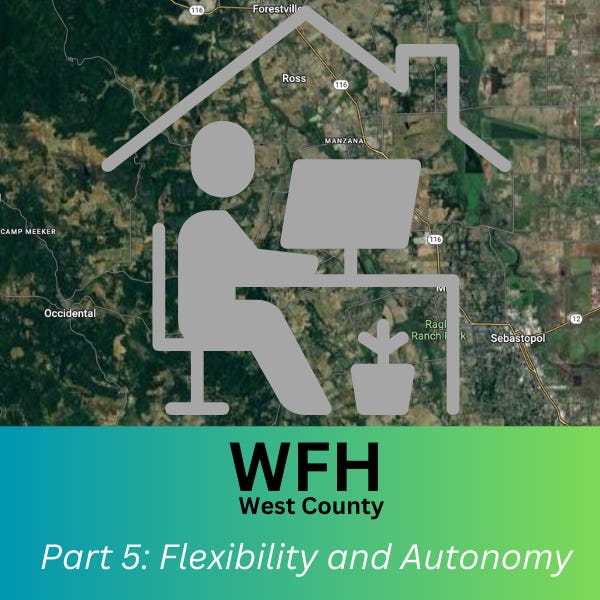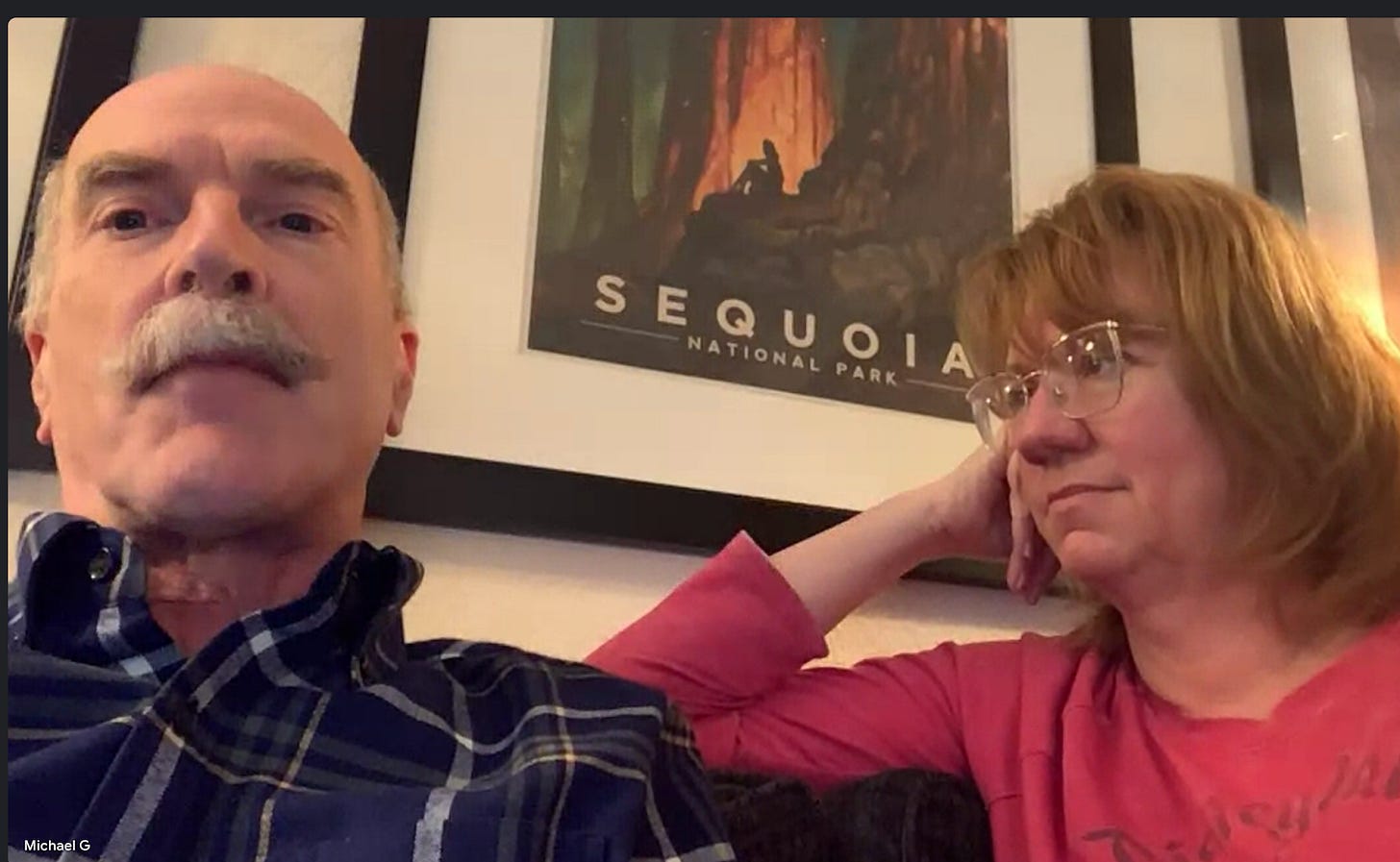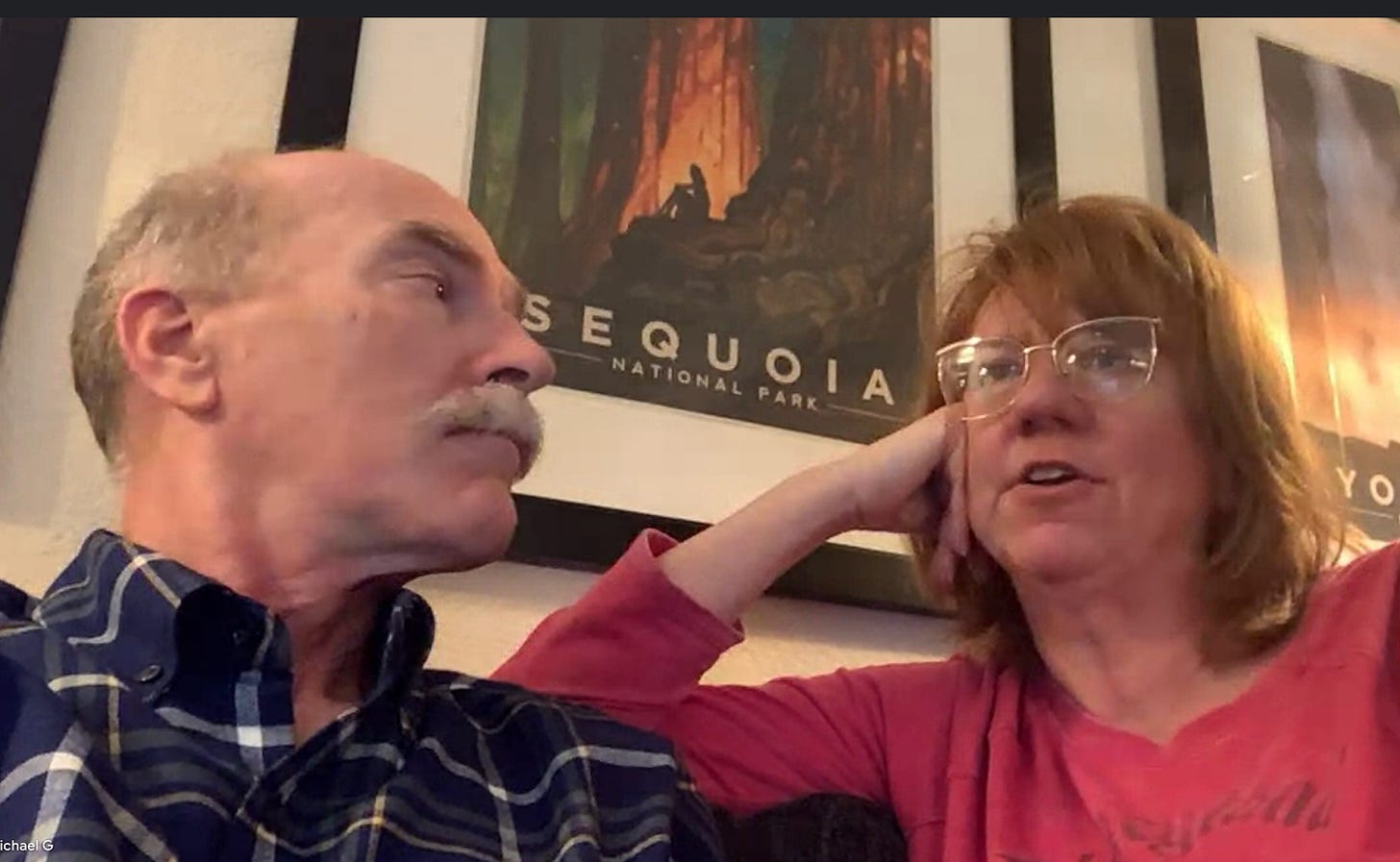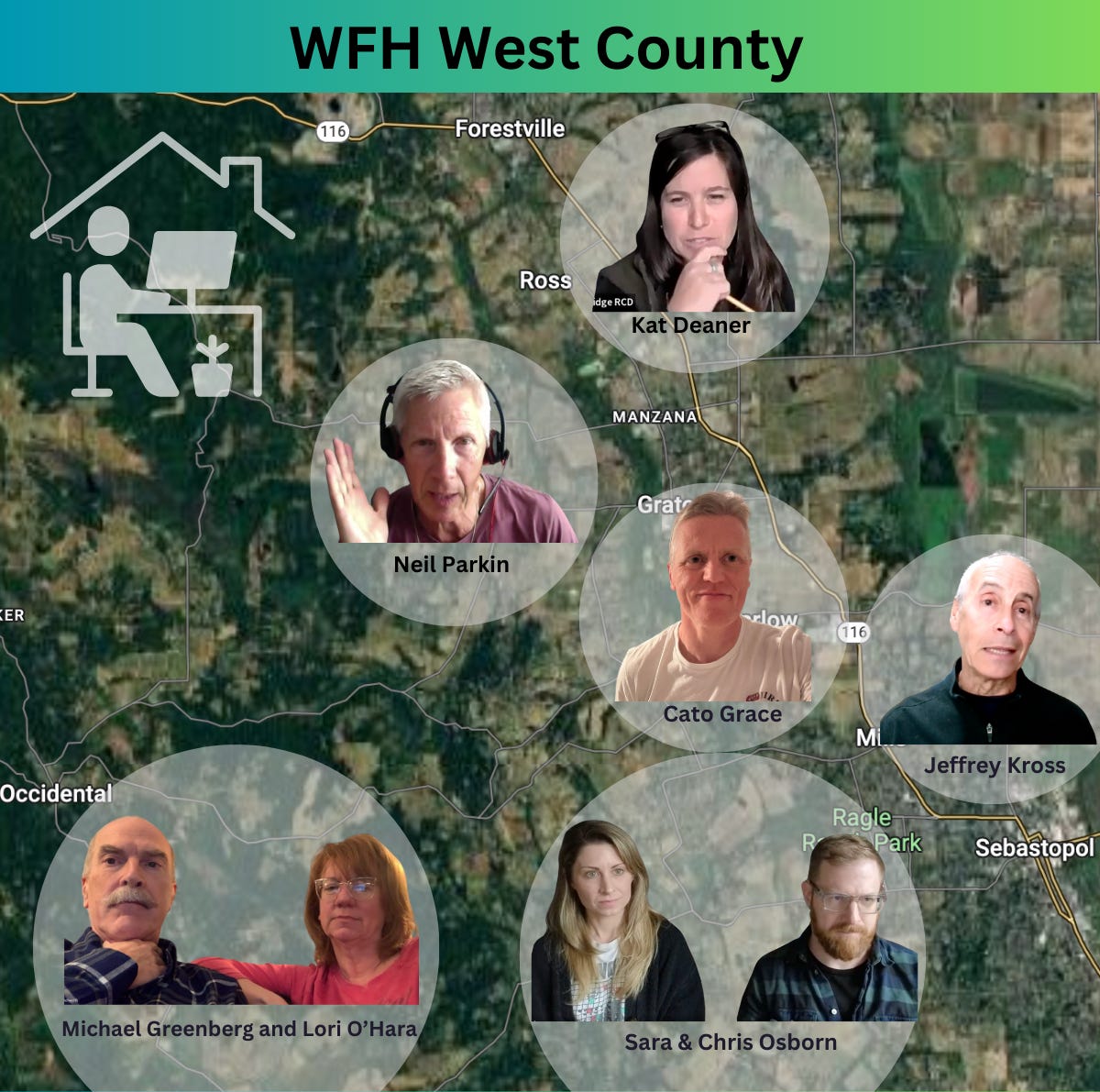WFH West County: Flexibility and Autonomy
The fifth and final part of a series on those who prefer to work from home: meet Michael Greenberg and Lori O'Hara
This is the fifth and final part of a series that looks at the shift to remote work in Sebastopol and West County, what might be considered a hidden-away-at-home workforce. WFH is changing where and how people work today, offering a good living in a good place to live and work. Catch up:
Although remote work is not for everyone, those who work from home prefer it for a number of reasons. Flexibility and autonomy seem to be at the top of the list.
Both men and women agree that the biggest benefits of remote and hybrid work include less burnout, higher productivity, more autonomy, efficient time management, and improved work-life balance.
Remote and hybrid work has also proven less stressful, with 59% of full-time office workers saying their stress levels increased in the past year. In contrast, only 55% of hybrid workers and 36% of remote workers said this was the case.
Remote Work Statistics for 2024
While WFH has lifestyle benefits, it also provides flexibility in a changing job market, especially for working couples who are changing jobs or holding jobs in a changing economy. Those who work from home seem to be very adaptable to change.
WFH Profile: “You have to be your own engine.”
Michael Greenberg and Lori O’Hara
Michael Greenberg is an optical engineer who worked on laser systems for the Stanford Linear Accelerator (SLAC) in Menlo Park. A native of Sonoma County, Lori O’Hara was trained as a speech pathologist but now works for Ensign, a company that operates skilled nursing facilities across the western US.
“We moved to our home in Occidental in 2013. I started at the SLAC lab in 2016,” said Michael. “Lori has worked remotely since 2013. Her remote work arrangement is what gave us the flexibility to allow me to take the job at SLAC.” The couple began commuting to a tiny apartment in Redwood City for the work week and returned home on weekends. “After the Tubbs fire, we moved to the Redwood City apartment full-time and rented out our home,” said Michael. Then, during COVID, we moved back to Occidental full-time when the lab loosened its remote worker policies.” He added: ”We were both homesick for Sonoma County - and particularly for West County, by the time the COVID crisis began.”
Michael’s work at SLAC was hands-on as an engineer working with “lots of optics.” He began work on designing a new laser system that would take six to eight years to complete. “That work changed the character of my job," he said. He didn’t need to work in the lab, and he began managing younger people who eventually took over the work once he retired. He works as a consultant for SLAC, mostly mentoring a team that he says is competent and doesn’t really need to check in with him, but they do anyway. “I’m like a dad watching a child riding a bike with training wheels, but they don’t need me anymore.”
As a speech pathologist, Lori worked with older adults mostly, and she ended up working in skilled nursing facilities. When the company said that they needed a specialist to help them respond to Medicare audits, she raised her hand, knowing that she didn’t have any particular qualifications for the job. She not only got the job, but she now manages a team of 25 people from coast to coast who work remotely, serving facilities in the 16 states where Ensign operates. Most of the work involves writing reports and conducting research as part of the Medicare appeals process. For 12 years, she’s worked remotely and likes it, but admits it’s not for everyone.
“You have to be your own engine,” said Lori, meaning that you have to be self-motivated and self-sufficient. “You don’t have people to come to your desk to solve a technical problem,” she said. “You have to figure out the tech yourself.” One new team member was such an extrovert that, after 3-4 months, he realized that he couldn’t work from home. “He said he was sad being alone at home,” she said. “For some, working from home can be lonely.”
Lori’s got that type of engine, which she mentioned, and I could tell that she enjoys her job and working with her team. Her people are really productive, and she’s never had to worry if people are doing their jobs. The group has quintupled the number of reports it has produced. (The company is five times larger.) “It is sometimes hard to tell if people are working too hard,” she said. “We feel connected as a team, and we have a high level of communication.”
She speaks highly of the company that she works for. “I’d never worked for a company as committed to fostering a positive work culture and to the well-being of its employees in equal measure to the well-being of its customers as Ensign is to its culture and employees.”
Michael works in a spare bedroom while Lori has squeezed herself into an upstairs landing that is about 4x6’, and she really likes it. “We kiss at the top of the stairs, and we say ‘Have a good day’ and then later we meet for lunch,” she said.
Lori appreciates the flexibility that comes with remote work. “I can take a walk or go to a doctor’s appointment if I need to,” she said. “I would hate to lose that flexibility.”
She loves working remotely and loves her work. “Managing a team that I never get to actually see has its own unique set of challenges, but I’m lucky enough to have found and retained incredible people. The fact that we’re all over the country and in home offices doesn’t impact our quality or team culture at all.”
Lori knows a woman who worked in a community college in Sacramento and not only began working from home but relocated to southern California, finding a “nice home near the beach.” Her employer changed its policy earlier this year, requiring her to be in the office one day a week. She takes a flight to Sacramento on Tuesdays to meet that one-day-in-the-office requirement.
While there are companies that have WFH policies, some have begun insisting that employees come into the office, so-called Return to Work policies, like the State of California. Others actively support their employees working remotely, and it allows them to recruit qualified employees regardless of where they live.
WFM may not be for everybody at every age. Yet, for those who are fortunate to have the ability to work from home in a place they love to call home, it is pretty close to a dream job.
Future of Remote Work
That dream job could be in danger, however. In the future, according to an article in the New York Times, Daniel Kokotajlo speculates that remote worker could be an AI bot, possibly replaced humans in various roles.
Basically, you can think of (AI) as a remote worker, except that the worker itself is virtual — it’s an A.I. rather than a human. You can talk with it and give it a task, and then it will go off and do that task and come back to you half an hour later — or 10 minutes later — having completed the task, and in the course of completing the task it did a bunch of web browsing. Maybe it wrote some code and then ran the code, edited it and ran it again. Maybe it wrote some word documents and edited them.
– Daniel Kokotajlo
I’d bet that many of the people interviewed in this series will be assisted by AI, not replaced by AI, starting now and even more so in the future. How AI might impact the economy of Sonoma County and the people who work here is perhaps a topic to consider for a future series.
Thanks to all who shared their WFH stories with Sebastopol Times.
#1 Cato Grace
#5 Kat Deaner
#6 Michael Greenberg and Lori O’Hara (above)






